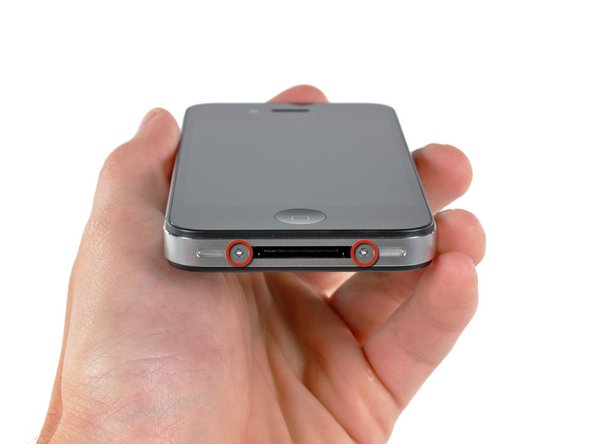Esta versión puede contener ediciones incorrectas. Cambiar a la última instantánea verificada.
Qué necesitas
-
-
La caja posterior de tu iPhone 4 puede fijarse bien con dos tornillos Phillips #000 o bien con tornillos Apple de 5-Puntos (segunda imagen). Comprueba cuáles tienes y asegúrate de que tienes el destornillador adecuado para retirarlos.
-
Retira los dos tornillos Pentalobe o Phillips #000 de 3.6 mm que están junto al conector para el cargador.
-
-
-
Remueve el único tornillo de 2.5 mm Phillips que asegura el conector de la batería a la tarjeta lógica.
-
-
-
Usa la pestaña de plástico clara para levantar gentilmente la batería fuera del iPhone.
-
Si hay solución de alcohol restante en el teléfono, límpialo cuidadosamente o permite que se seque antes de instalar la batería nueva.
-
Antes de reconectar el conector de la batería, asegúrate que el clip de contacto (mostrado en rojo) este propiamente posicionado a lado del conector de la batería.
-
-
Este paso está sin traducir. Ayuda a traducirlo
-
Remove the following two screws:
-
One 1.2 mm Phillips
-
One 1.6 mm Phillips
-
Remove the thin steel dock connector cable cover from the iPhone.
-
-
-
Este paso está sin traducir. Ayuda a traducirlo
-
Use a plastic opening tool to gently pry the dock cable connector up off the logic board from both short ends of the connector.
-
-
Este paso está sin traducir. Ayuda a traducirlo
-
Carefully peel the dock ribbon cable off the logic board and the lower speaker enclosure.
-
-
Este paso está sin traducir. Ayuda a traducirlo
-
Use a plastic opening tool to pry the lower antenna connector up off its socket on the logic board.
-
-
Este paso está sin traducir. Ayuda a traducirlo
-
Remove the following screws securing the speaker enclosure assembly to the outer case:
-
One 1.9 mm Phillips screw
-
One 2.4 mm Phillips screw
-
-
Este paso está sin traducir. Ayuda a traducirlo
-
Use a plastic opening tool to lift the speaker enclosure assembly out of the case, being sure not to damage the EMI fingers on the attached Wi-Fi antenna.
-
Remove the speaker enclosure assembly.
-
-
Este paso está sin traducir. Ayuda a traducirlo
-
Use the edge of a plastic opening tool to carefully peel the bottom edge of the dock connector assembly off the adhesive securing it to the rear case.
-
-
Este paso está sin traducir. Ayuda a traducirlo
-
Remove the two 1.3 mm Phillips screws securing the dock connector to the rear case.
-
-
Este paso está sin traducir. Ayuda a traducirlo
-
Use the tip of a spudger or your fingernail to flip up the home button ribbon cable retaining flap.
-
Use a pair of tweezers to gently pull the home button ribbon cable out of its socket. Note its position for reinsertion.
-
-
Este paso está sin traducir. Ayuda a traducirlo
-
Use the flat edge of a spudger to carefully peel the left edge of the dock connector assembly and its ribbon cable off the adhesive securing it to the rear case.
-
Pry the right edge of the dock connector off the rear case.
-
-
Este paso está sin traducir. Ayuda a traducirlo
-
Use the flat edge of a spudger to push the lower microphone away from the bottom edge of the iPhone.
-
-
Este paso está sin traducir. Ayuda a traducirlo
-
Remove the dock connector assembly from the iPhone, minding any cables that may get caught.
-
-
Este paso está sin traducir. Ayuda a traducirlo
-
Slide the rubber cover off the microphone attached to the old dock connector and transfer it to your new dock connector.
-
The ribbon is very fragile and can easily be torn when placing the rubber cover onto your new part.
-
Cancelar: No complete esta guía.
503 personas más completaron esta guía.
Documentos Adjuntos
26 comentarios
I found a cool iPhone 4 universal dock adapter that may help protect the connector from being damaged in the first place. It is called the LCYO Adapter (http://www.synthecept.com) and lets you dock the phone without removing the case. Just a thought, like I said it might help avoid a damaged connector!
I successfully did this, however now my mic is not working unless I am on speaker or using my headphones... anyone else have this problem?
thanks,
D
I had two different little pieces of plastic on my replacement on the mic that I needed to peel off. You may have left some on. Not the easiest to check, but a possibility.
I had the same problem - nonfunctioning lower mic upon reassembly after replacing dock connector. Took it apart again, removed and reinstalled the dock connector paying special attention to the mic. Still no luck upon reassembly the second time. Any ideas? Bad/damaged mic?
Removing the logic board seems to be unnecessary. I was able to replace the dock connector by simply removing the speakers and battery.
Also, it'd be nice if the dock connector came with a new moisture sensor.






























